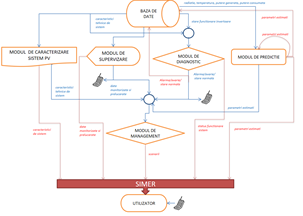Cuprins
- Colectarea şi analiza datelor privind energia
- Determinarea utilizatorilor semnificativi de energie
- Stabilirea influenţei diferitor factori asupra utilizării de energie
- Stabilirea liniei de bază şi determinarea indicatorilor de performanţă energetică
- Linia de bază
- Indicatorii de performanţă energetică IPEn
- Identificarea cerinţelor legale şi de altă natură
- Identificarea oportunităţilor pentru îmbunătăţire
- Stabilirea obiectivelor şi ţintelor energetice
- Elaborarea planurilor de acţiuni
- Bibliografie

Bibliografie
[1] Katsinoulas L., Papoutsidakis M., Tseles D., Smart home applications for energy saving and increased security, International Journal of Computer Applications, vol. 175, no. 8, pp. 38–44, Oct. 2017.
[2] Sami B.S., An intelligent power management investigation for stand-alone hybrid system using short-time energy storage. International Journal of Power Electronics and Drive Systems 8.1, 367, 2017.
[3] Yamagishi H., Microbial contamination and countermeasures in home bathrooms and toilets, Indoor Environment, vol. 22, no. 1, pp. 73–79, 2019.
[4] Kim S., Christiaans H., Baek J.S., Smart Homes as Product-Service Systems: Two Focal Areas for Developing Competitive Smart Home Appliances. Service Science 11.4, 292-310, 2019.
[5] Mehrjerdi H., Peer-to-peer home energy management incorporating hydrogen storage system and solar generating units. Renewable Energy 156, 183-192, 2020.
[6] Yoon J., Deep-learning approach to attack handling of IoT devices using IoT-enabled network services. Internet of Things 11, 100241, 2020.
[7] Kim Junyon, HEMS (home energy management system) base on the IoT smart home. Contemporary Engineering Sciences 9.1 21-28, 2016.
[8] Ikpehai A., Adebisi B., Rabie K.M., Broadband PLC for Clustered Advanced Metering Infrastructure (AMI) Architecture. Energies 9, 569, 2016.
[9] Ahmed M.A., Kang Y.C., Kim, Y.C., Communication Network Architectures for Smart-House with Renewable Energy Resources. Energies 8, 8716–8735, 2015.
[10] Bradac Z., Kaczmarczyk V., Fiedler P., Optimal Scheduling of Domestic Appliances via MILP. Energies 8, 217–232, 2015.
[11] Collotta M., Pau G., A Novel Energy Management Approach for Smart Homes Using Bluetooth Low Energy. IEEE J. Sel. Areas Commun. 33, 2988–2996, 2015.
[12] Pascual J., Sanchis P., Marroyo L., Implementation and Control of a Residential Electrothermal Microgrid Based on Renewable Energies, a Hybrid Storage System and Demand Side Management. Energies 7, 210–237, 2014.
[13] Collotta M., Pau G., A Solution Based on Bluetooth Low Energy for Smart Home Energy Management. Energies 8, 11916–11938, 2015.
[14] Collotta M., Pau G., An innovative approach for forecasting of energy requirements to improve a smart home management system based on BLE. IEEE Trans. on Green Commun. and Net. 1.1, 112-120, 2017.
[15] Fan W., Liu N., Zhang J., An Event-Triggered Online Energy Management Algorithm of Smart Home: Lyapunov Optimization Approach. Energies 9, 381, 2016.
[16] Fan W., Liu N., Zhang J., Lei J., Online Air-Conditioning Energy Management under Coalitional Game Framework in Smart Community. Energies 9, 689, 2016.
[17] Nguyen T.T.K., Shimada K., Ochi Y., Matsumoto T., Matsugi H., Awata T., An Experimental Study of the Impact of Dynamic Electricity Pricing on Consumer Behavior: An Analysis for a Remote Island in Japan. Energies 9, 1093, 2016.
[18]Sustainable Energy Authority of Ireland,
www.seai.ie/Your_Business/Large_Energy_Users/Resources/Energy_Management_Systems/
[19] Organizaţia Naţiunilor Unite pentru dezvoltare industrială, Ghid Practic pentru Implementarea unui Sistem de Management Energetic, https://odimm.md/files/ecologizare/Ghid-Practic-implementare-EnMS-rom.pdf
[20] Standard ISO 50001: 2018 Managementul energiei – Sisteme de management al energiei.
[21] Monitoring and Targeting – in-depth management guide – Carbon Trust,
http://www.carbontrust.com/media/31683/ctg008_monitoring_and_targeting.pdf
[22] Ordinul 1287/2018 pentru aprobarea Ghidului de finanţare a Programului privind instalarea sistemelor de panouri fotovoltaice pentru producerea de energie electrică, în vederea acoperirii necesarului de consum şi livrării surplusului în reţeaua naţională
[23] Dragomir O.E., Dragomir F., Forcasting of renewable energy load with radial basis function (RBF) neural networks. The 8th International Conference on Informatics in Control, Automation and Robotics, (pp. 409-412), 2011. Noordwijkerhout, Olanda.
[24] Dragomir O. E., Dragomir F., MLP neural network as load forecasting tool on short- term horizon. The 19th Mediterranean Conference on Control and Automation, (pp. 1265 – 1270), 2011 Corfu, Grecia.
